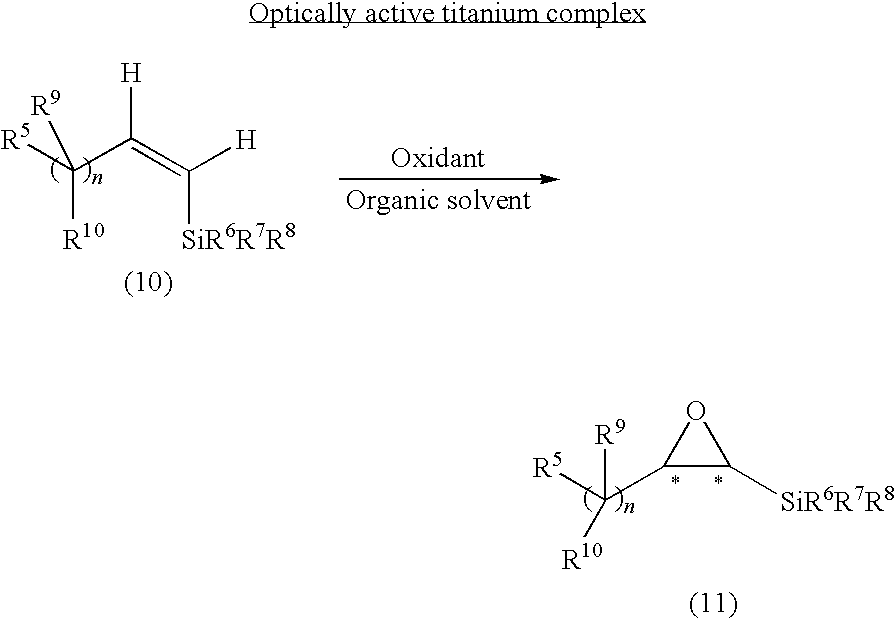Process for producing optically active cis-silyl olefin oxide compound
- Summary
- Abstract
- Description
- Claims
- Application Information
AI Technical Summary
Benefits of technology
Problems solved by technology
Method used
Image
Examples
example 1
Asymmetric Oxidation of Alkenylsilane
[0132]
[0133]A titanium salalen complex 1 (4.5 to 18 mg, 0.5 to 2.0 mol %) of the above formula and alkenylsilane (0.50 mmol) were dissolved in CH2Cl2 (0.50 mL) and thereto, 30 to 35% hydrogen peroxide water (85 μL, 0.75 mmol) was added, followed by stirring the resultant reaction mixture at 25° C. After the completion of the reaction, the mixture was purified by silica gel column chromatography using n-pentane as a developing solvent to produce the objective epoxysilane. The optical purity (ee) thereof was determined by an optically active HPLC analysis.
example 2
Production of Styrene Oxide from Epoxysilane
[0134]The epoxysilane was dissolved in THF (4 mL / mmol). Thereto, tetrabutylammonium fluoride (TBAF) (1 molL−1 THF solution, 1.5 to 2 equivalents) was added and the resultant reaction mixture was stirred at a room temperature or 50° C. After the completion of the reaction, the mixture was extracted with diethyl ether and the extract was washed with water and saline and dried over Na2SO4. The crude product was purified by silica gel chromatography using n-pentane / diethyl ether as a developing solvent to produce a corresponding epoxide. The optical purity (ee) thereof was determined by an optically active HPLC analysis.
[0135]Hereinafter, the yield, the optical purity and the physical properties of the compound produced according to Examples 1 and 2 are shown. In addition, CHIRALPAK IC, CHIRALCEL OD-H, CHIRALPAK AD-H, CHIRALPAK IA and CHIRALCEL OJ-H which were used for the determination of the optical purity are registered trademarks of Daicel...
example 3
Asymmetric Oxidation of Alkenylsilane No. 2
[0158]To a dichloromethane solution (0.5 mL) of a salan ligand (27 mg, 0.050 mmol) (10 mol % based on the mol of the substrate) of Formula 2:
titanium tetraisopropoxide [Ti (Oi-Pr)4] (2.8 mg, 0.010 mmol) was added at 20° C. The resultant reaction mixture was stirred at 20° C. for 1 hour and to the reaction mixture, a CH2Cl2 (0.50 mL) solution of cis-1-dimethyl (phenyl) silyl-2-phenylethylene (0.50 mmol) was added, followed by adding 30 to 35% hydrogen peroxide water (85 μL, 0.75 mmol) and by stirring the resultant reaction mixture at 40° C. After the completion of the reaction, the mixture was purified by silica gel column chromatography using n-pentane as a developing solvent to produce the objective dimethyl(phenyl) ((2R,3S)-3-phenyloxirane-2-yl] silane. The yield and the optical purity (ee) were 59% and 99% ee respectively.
PUM
 Login to View More
Login to View More Abstract
Description
Claims
Application Information
 Login to View More
Login to View More - R&D
- Intellectual Property
- Life Sciences
- Materials
- Tech Scout
- Unparalleled Data Quality
- Higher Quality Content
- 60% Fewer Hallucinations
Browse by: Latest US Patents, China's latest patents, Technical Efficacy Thesaurus, Application Domain, Technology Topic, Popular Technical Reports.
© 2025 PatSnap. All rights reserved.Legal|Privacy policy|Modern Slavery Act Transparency Statement|Sitemap|About US| Contact US: help@patsnap.com



